|
Mouse Letters
Publisher : Clarion, 1999. Comment : Combining the simplicity of Harold and the Purple Crayon with the palette of Winnie the Pooh, Arnosky cleverly demonstrates a mouse's creativity in constructing the letters of the alphabet out of sticks...Wee wit is plentiful in this pint-sized pleaser |
 |
|
Mouse Numbers
Publisher : Clarion, 1999. Comment : A determined mouse goes on an expedition, purple umbrella in hand. The mouse ventures from his zero-shaped burrow entrance, past one toadstool, up and down two hills, across three stepping stones, counting all the way to the beach-where he relaxes until the tide turns and a big fish with ten scary teeth sends him scurrying home, counting back down to zero. This wordless, but not quiet, story will engage young children, who will enjoy spotting the numerals in the mouse's landscape and discovering things to count when they go on adventures of their own. |
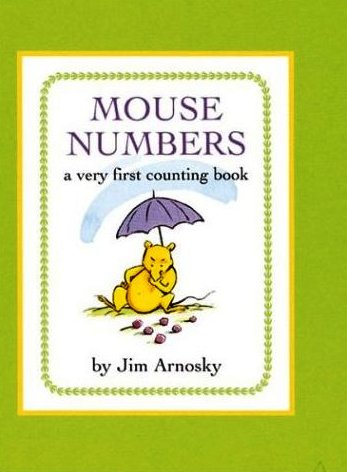 |
|
Mouse Colors
Publisher : Clarion, 2001. Comment : A pint-size artist demonstrates the magic of mixing colors, creating secondary colors—orange, green, and purple—from combinations of primary colors—red, blue, and yellow. After painting a colorful ship, he climbs aboard and sails away into the sunset. |
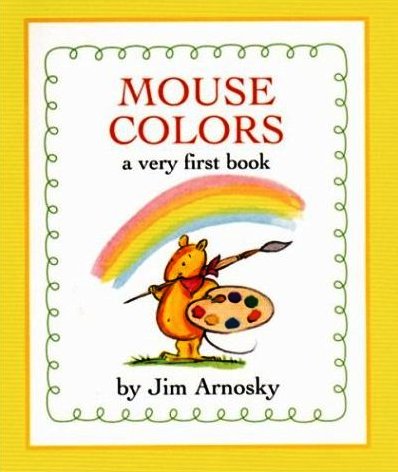 |
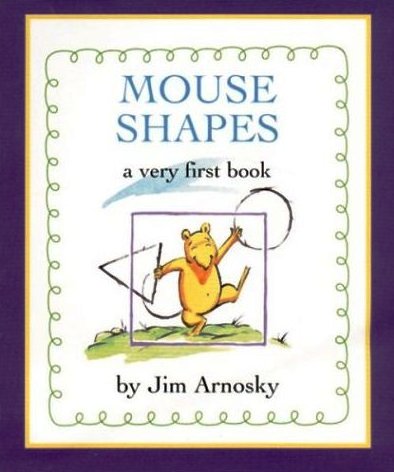 |
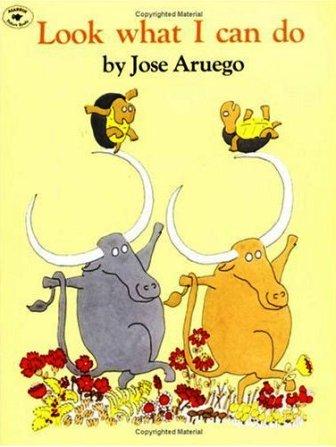 |
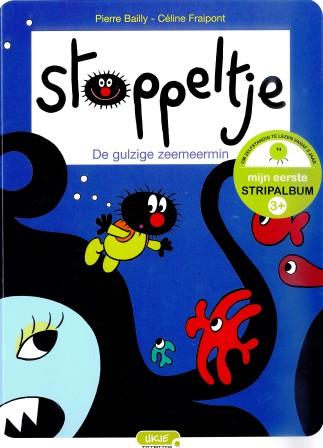 Page |
|
Window
Publisher : Greenwillow, 1991. Comment : A mother, holding her newborn son, gazes out the window of his room at lush vegetation, tropical birds, a pond, a kangaroo. Ten double-page illustrations following show the development--during a 20-year period--of the area outside the window. As Sam (the baby) grows older, the land is cleared, a road is built, then a farm. A housing development goes up, then takes over a hill that was once green with lush growth. Development becomes suburb, then city, complete with billboards, high-rises, noise pollution, litter, and overpopulation. Sam marries and moves to a new house in the country, where the final window scene shows him, holding his baby, staring at a sign announcing, "House Blocks For Sale". Words are unnecessary, as Baker's carefully rendered collage scenes explicitly detail the situation. Varying symbolic objects on Sam's windowsill (and the cracking and peeling of paint on the wall) add to the book's message. Baker's meticulous collages, formed from natural materials, clay, fabric, and real hair, are so detailed that they require many viewings. A final, short author's note explains the inspiration for the book: ". . .by understanding and changing the way we personally affect the environment, we can make a difference." This unusual, exceptionally well-crafted picture book might be a good way to begin. --- Susan Scheps |
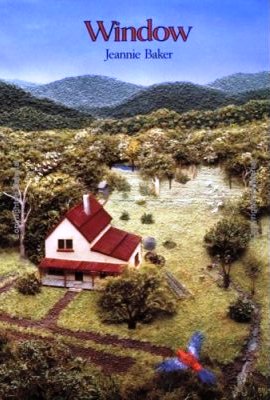 Page |
|
Home
Publisher : Greenwillow, 2004. ISBN : 9780066239354. Comment : When baby Tracy is first brought to her new home, the view of the urban neighborhood as seen through her window is not a pleasant one. Billboards and graffiti are everywhere, garbage is strewn across the streets, and only a few meager plants are fighting their way through the cracks in the cement. Bit by bit, as Tracy grows, the area is slowly reclaimed, so that the final view through the window is clean, lush, and green, with birds nesting peacefully in new trees and vistas that reveal glimpses of the now-visible blue river. In each of the double-page views through the window, readers can note not just the physical changes, but also the people in the community actively engaged in affecting those changes and producing a true home. As she did in Window (Greenwillow, 1991), Baker uses natural materials to create detailed, arresting collages that tell a story in which words are superfluous. Children can pore over these pages again and again and make fresh discoveries with each perusal. Whether enjoyed independently or incorporated into units on the environment, communities, or artistic technique, this is a book to treasure.--Grace Oliff |
 |
|
The Grey Lady And The Strawberry Snatcher
Publisher : Simon & Schuster Children Publishing, 1984. Comment : The award-winning artist has conceived and realized an extraordinary picture book. Bang's illustrations are unparalleled in effects, full-color paintings and collages in which the surrealistic and the representational combine to tell a story without words. |
 Page |
|
Zoom
Publisher : New York: Puffin, 1998. Comment : This wordless picture book begins as an ant’s eye view of the universe—if the ant had a talent for draftsmanship and an imagination as expansive as outer space. The first page is a hard-to-identify jagged red shape which becomes… something else. The wonder and surprise of the book is in how the illustration on each page blossoms from the previous one, sending the “reader” through dozens of layers of reality, and challenging our conventional notions of the beginning and the end of our perceptions. |
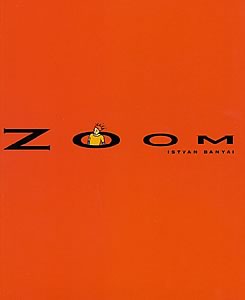 Page |
|
Re-Zoom
Publisher : New York: Puffin, 1998. Comment : The unique magic of Zoom is revisited in Re-zoom, another wordless journey that bends the mind and turns reality upside down. Zoom from an Egyptian pyramid to an exotic jungle to a sandy beach—you never know what’s on the next page, because in the world of Re-zoom nothing is as it seems. The book is a wonder of visual magic, but it’s also quite thought provoking. An ideal gift for children, adults, or anyone who likes to think outside the box. |
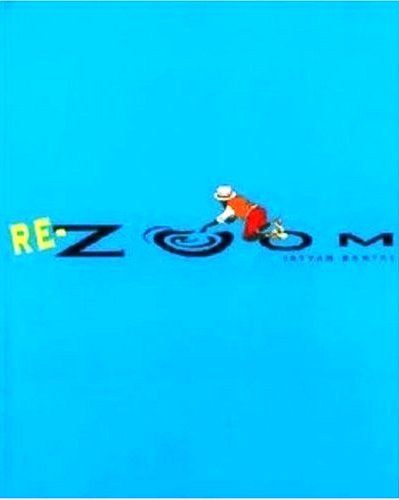 |
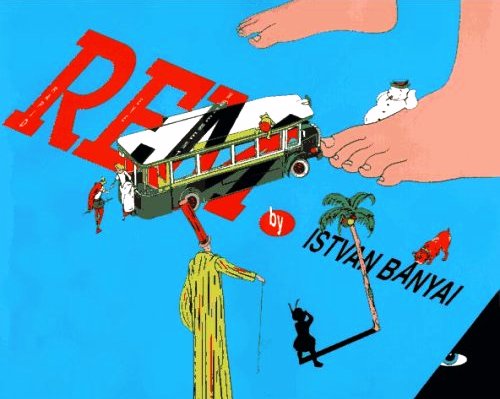 |
|
Other Side
Publisher : New York: Chronicle, 2005. Comment : In The Other Side, artist, designer, commentator, provocateur Istvan Banyal takes us on another exceptional visual journey. In graphically stunning illustrations that feature many clever twists in point of view, familiar scenes turn and turn again to show us the back, the front, the top, the bottom, the opposite, the other side of each perspective. Here's is a door. What's on the other side? Here's a curtain. What's on the other side? Delightful, sly, funny and challenging. The Other Side will make you look and think twice! |
 Page1 Page2 |
|
Minus Equals Plus
Publisher : New York: Harry Abrams, 2001. Comment : The first published collection of work by illustrator Istvan Banyai, whose work portrays the dream lives of today's New York and Los Angeles hip urban style-setters. Banyai's repertoire of visual special effects is perfectly suited to a pop culture in which anything - appearance, identity, status - can be morphed into its opposite. In his universe, reflections and shadows become alternative realities, faces are interchangeable, and sex is a game played with laptop and webcam. |
 Page1 Page2 Page3 |
|
Bus 24
Publisher : New York : Harlin Quist, Dist. by Dial Press, 1973. Comment : Also known as Number 24. |
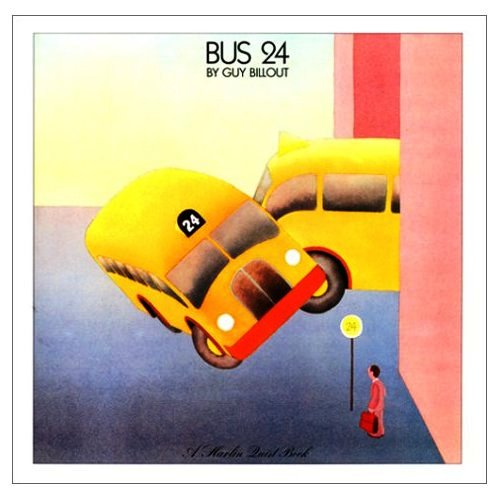 |
|
Journey: Travel Diary of a Daydreamer
Publisher : Creative Editions, 1994. Comment : The nearly wordless picture book follows a boy on a train ride that, judging from the surreal scenes viewed from his train window, transcends the laws of time and space. Dinosaurs cavort over a rail bridge, and wolves crawl under a moat as if it were a blanket in the sleek illustrations, which are captioned by spidery text that reinforces the book's dreamlike quality. The Horn Book, Inc |
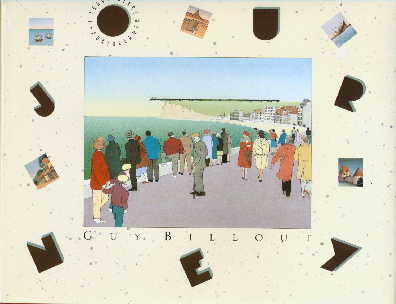 |
|
Clown
Publisher : New York: Henry Holt, 1996. Comment : A charming book that could be characterized as "a silent film between book covers". Follow the fortunes of Clown, an exuberant fellow who starts out in a dustbin but ends up with a happy family in this inventive picture story. Master illustrator Quentin Blake has created an irrepressible character, an action-filled plot and an eloquent story that can be read on several levels--all without the use of a single word. |
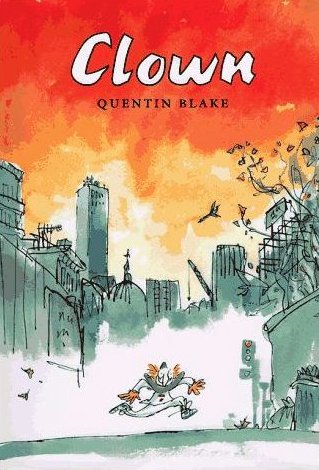 Page |
|
Playtime
Publisher : Purton, Wilts. : Child's Play (International) Ltd, 1975. Comment : Illustrated by Claude d'Ham. |
|
The Snowman
Publisher : London: Hamish Hamilton, 1978. Comment : A little boy makes a snowman. When he looks through the window at night, the snowman has come to life. The little boy shows the snowman around the house and later they go and visit Father Christmas. When the boy wakes up in the morning, the snowman has melted. Comment : The snowman is also a fantastic animation movie. |
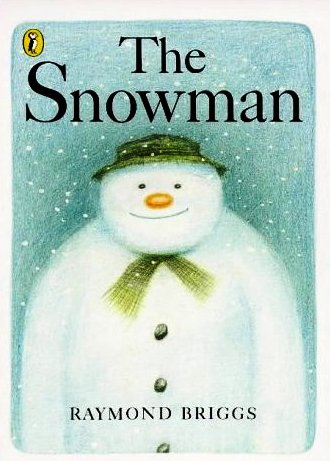 |
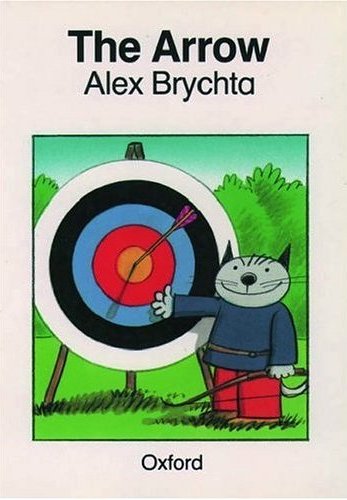 |
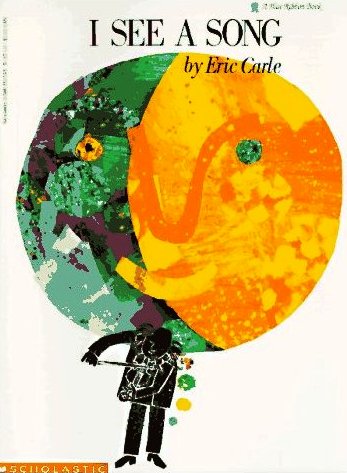 |
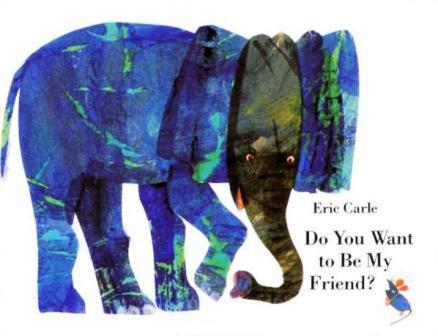 |
|
A Circle of Friends
Publisher : Star Bright Books, 2003. Comment : In this wordless story about a circle of kindness, a boy leaves the lion's share of his fresh muffin with a homeless man sleeping on a park bench. When the man wakes, he shares crumbs with two birds that feed them to a fledgling. Later, the young bird flies down from its nest, picks up a seed that the man offers from his palm, and deposits it in the window box of the boy who is later blessed with an enormous sunflower. Carmi sparingly accessorizes the line drawings with color, using gold, scarlet, or green to highlight an element on each page that will carry the kindness forward. This simple tale makes its point without being didactic or overly sentimental. --- Gay Lynn Van Vleck |
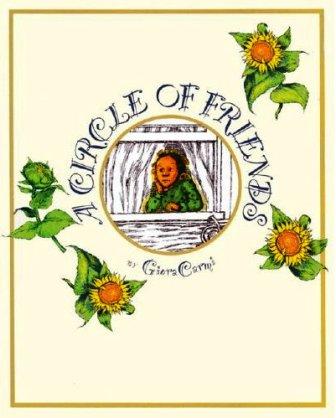 Page |
|
The Alphabet Parade
Publisher : Voyager, 1994. Comment : A festive, colorful, and offbeat alphabetical parade romps through and off the pages of this wordless book. Spectators, pictured in the foreground, hold appropriate props or do something inspired by the letter passing before them. The featured letter is incorporated into the page design that is filled with both usual and unique paraders. A listing of pictured items is appended, although it's not complete; young eyes may discover more in this book not unlike Handford's Where's Waldo? (Little, 1987), but less cluttered and not as garishly hued. A clever volume that may stimulate discussion. --Maria B. Salvadore, District of Columbia Public Library. |
|
on Christmas Eve
Publisher : Knopf, 1990. Comment : Colored-pencil drawings in muted shades tell this wordless story of a little girl whose Christmas is aided by fairies as well as by Santa Claus. The dedication "to chimneyless children everywhere" justifies the helping fairies , but readers don't see that the house lacks a chimney until well into the story. A fairy tucks the girl's letter to Santa in her belt and opens the outside door to other fairies who borrow candles to light the way for Santa's sleigh to land. At the girl's bedside, Santa nearly blows his cover when he drops a gift and the sleeping girl awakes to enjoy her presents by herself, an act that some children may find very curious. |
 |
|
The Midnight Circus
Publisher : Knopf, 1992. Comment : Without words, Collington weaves an elaborate and dramatic story that will appeal to any child who revels in heroic dreams. A young boy loves the mechanical horse in front of the store next door to his home, and when the shopkeeper has it removed, the child cries himself to sleep. Even the child's wonderful picture book about a brave cowboy in the circus isn't enough to ease the hurt. But awakening in the night, the boy finds the horse again and travels with it to a magical nighttime circus. In grand, heroic tradition, he bests a great beast before returning home, fast asleep, astride the back of his trusty steed. The next day, he wakes up to discover that the mechanical horse that served him so well is back in front of the shopkeeper's door. The pleasantly predictable story is strengthened by artwork that is not a bit sentimental or sweet. The colored-pencil pictures, appearing in crystal clear sequence, vary in size from more than full-page to quite small. The boy's seesawing emotions are plainly rendered, and the exacting, fascinating details of the drawings will keep little lookers busy, but not to the extent that they'll ever lose track of the story. A wonderful excursion into a realm where fantasy and reality collide. Stephanie Zvirin |
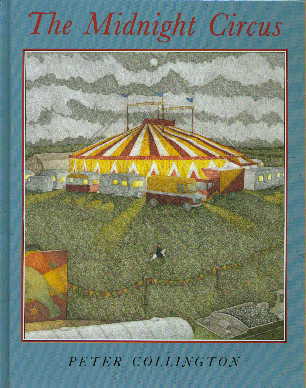 |
 Page
Page
|
|
The Marvelous Misadventures of Fun-Boy
Publisher : Viking Juvenile, 2006. Comment : This innovative wordless picture book contains twelve laugh-out-loud stories about a little boy looking for adventure. But all he seems to find are misadventures. In one tale, Fun-Boy rushes to put out a raging fire with the garden hose—only to douse the backyard grill and ignite the anger of his father. In another, Fun-Boy is happily swinging through a leafy jungle—until he falls from his bed and realizes it was only a dream. |
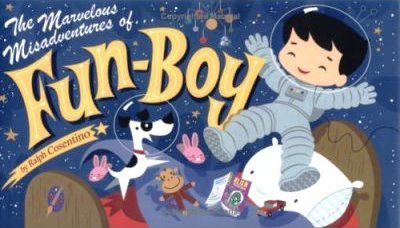 Page1 Page1 |

|
|
Va Faire Un Tour
Publisher : France: Pastel / L'ecole des loisirs. Comment : A small boy is send outside by his mother, who is preparing dinner. Angry, he walks away through the landscape, through the sea with its fish and shells, through the english countryside, through Loch Ness with its monster, until he is around the world and returns home. Meanwhile, the soup is ready. |
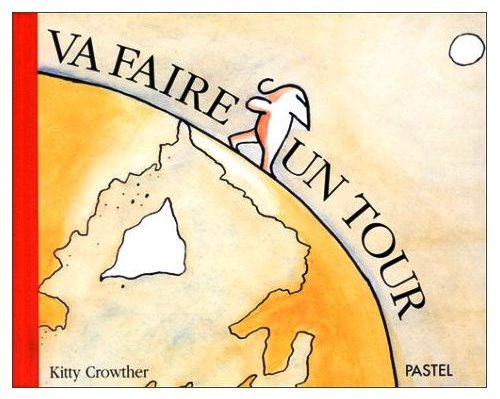
|
|
Good Dog Carl
Publisher : Farrar, Straus and Giroux, 1987. Comment : Alexandra Day's modern classic Good Dog Carl has sold more than 200,000 copies, captivating countless readers with the lovable rottweiler Carl, endearing illustrations, and the tale's surprising silliness. The book begins with the mother saying, "Look after the baby, Carl. I'll be back shortly." Let the adventure begin! Carl looks out the window to make sure Mom is gone. Once the coast is clear, the baby crawls out of the crib and onto Carl's back. First stop? Mom's bed. Second stop? The top of the dresser where powder puffs are sported as hats. The infant--now in Carl's capable paws--slides down the laundry chute, swims in the fish tank, dances, raids the refrigerator, and makes a huge mess. Carl dutifully bathes the baby, cleans up the chaos, puts his charge back in the crib, and plays it cool when Mom comes home. "Good dog, Carl!" she says upon her return. A sweet, subtly absurd picture book that jubilantly illustrates the old adage, "When the cat's away, the mice will play.". |
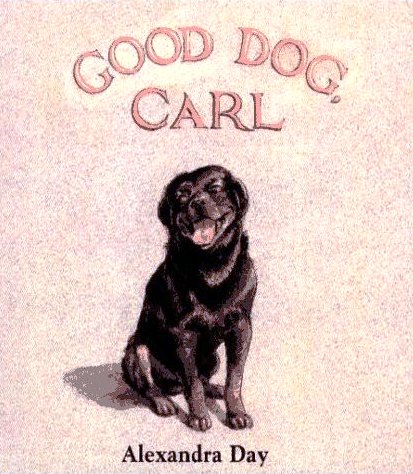
|
|
Carl goes shopping
Publisher : Farrar, Straus and Giroux, 1989. Comment : Carl the Rottweiler and the inquisitive baby are off and running again. In Good Dog Carl , this delightful duo confined its adventures to the house; here, mother displays more confidence in her "babysitter" by leaving the twosome by themselves in a busy department store while she goes in search of curtains. After a whirlwind inspection of the toy, millinery and book departments--baby is enthralled with a copy of Rottweilers I Have Known --Carl and his charge head for the electronics section where they try out the camcorders and manage to get themselves on all the TV screens. Famished after a romp through carpeting, they sample crackers and dog biscuits in the gourmet section. Spotting mother on her way to the "DOWN" escalator, the adventurers streak back to the carriage and innocently await her return. Animated tempera paintings convey the same endearing quality evidenced in Day's previous book; once again she presents a winning combination of hilarious and tender moments in this--practically--wordless charmer. |
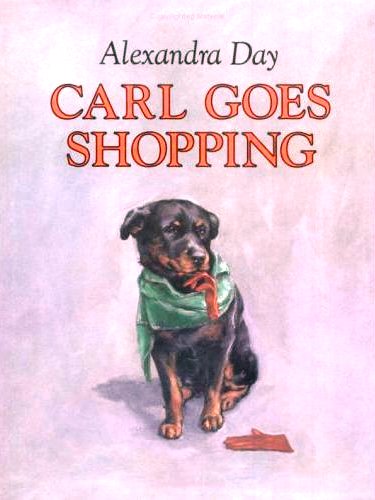
|
|
Carl's Christmas
Publisher : Farrar, Straus and Giroux, 1990. Comment : In this magical book, which will be enjoyed by dog-lovers of all ages, Carl the Rottweiler is left to mind the baby on Christmas Eve. No sooner than Mum and Dad are out of the door, Carl and Baby begin their Christmas adventure. Through beautifully detailed illustrations - the only text is on the first page - we follow them through the snow as they shop, sing carols, give gifts, meet Santa and finally go safely back to bed. |
 Page
Page
|
|
Carl's afternoon in the park
Publisher : Farrar, Straus and Giroux, 1991. Comment : Move over, Mary Poppins, and make room for Carl, the ravishing rottweiler cum babysitter who makes his fourth and perhaps finest appearance yet in this gorgeously colored picture book. As with the other Carl books, these adventures are virtually wordless. When a mother meets a friend in the park, she leaves Carl in charge of her baby and the newest addition to the series, a rottweiler puppy. Carl fans know what happens next: the baby scrambles aboard Carl's back and the romp begins. Here, however, the illustrations are more dynamic and the goings-on even more beguiling than in previous outings, making wonderful use of the park setting. Carl poses like a pony on the merry-go-round; the trio rides a tiny train into a children's zoo, where the puppy incurs a ewe's maternal wrath; while the puppy wreaks more havoc, Carl and the baby model for afternoon painters, each of whom styles his canvas after a famous artist. There's lagniappe too, for gifted puzzle enthusiasts--about 20 pictures of dogs have been hidden in the illustrations.. |

|
|
Carl's Masquerade
Publisher : Farrar, Straus and Giroux, 1992. Comment : Just when you thought Day had issued the dernier cri on the subject of Carl the capering canine (Carl's Afternoon in the Park , et al.), she tops herself by producing her most atmospheric book yet. Here, the rottweiler is bidden to mind the baby while the grown-ups attend a masquerade ball. Carl and baby, of course, tail the party-goers and join in the fun ("Oh! They must be Beauty and the Beast. Great costumes!" say the doorkeepers in one of the three spreads bearing text). Day has all but abandoned the small, multiple scenes used to convey a particular narrative development in the earlier Carl books--instead, settings are sumptuously evoked, fully peopled and lushly colored, packed with witty details (e.g., Carl and baby encounter a guest tricked out as Carl-and-baby; Carl and baby solve the problem of cutlery by feasting on popsicles; a bullfrog brass band keeps everyone hopping). Meanwhile, the party itself, with its site gaily festooned, its guests gotten up in magical guises and its many diversions, could be everybody's fantasy fiesta. All ages. |
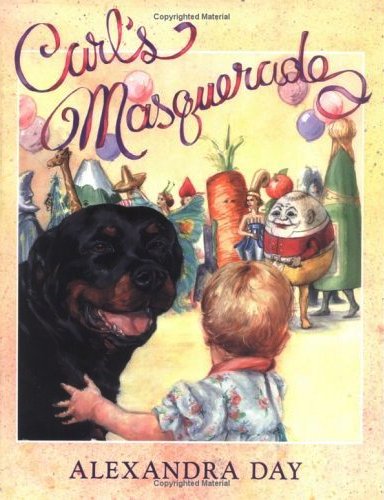
|
|
Carl pops up
Publisher : Farrar, Straus and Giroux, 1993. Comment : Fans of Good Dog, Carl know that when Mom says, "Look after the baby, Carl. I'll be back shortly," the excitement is about to begin, and this pop-up book is no exception. As soon as she's out the door, baby and dog are off on a wild afternoon filled with adventure. The first of many interactive pull-tabs has baby climbing out of his crib and onto Carl's back, which is like the bells ringing the start of a horse race--they're out of the gate and it's full speed ahead. Down the laundry chute, into the aquarium, and off to lunch--chocolate milk (heavy on the chocolate), cookies, and a little "butter" sandwich. Kids are sure to get a kick out of the miniature cuckoo that jumps from the clock, announcing cleanup time. As usual, Carl manages to erase all evidence of mischief and has the baby back in its crib when Mom walks through the door. With pull-tabs and pop-ups on every page, this book is sure to keep young "readers" as busy as Carl and the baby. --- Colleen Preston |
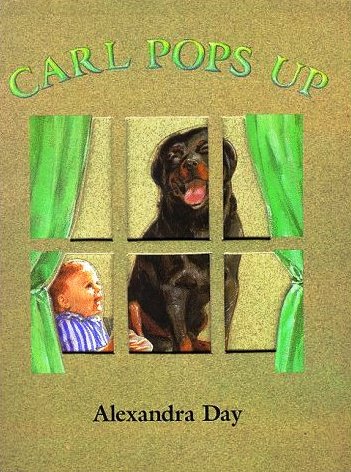
|
|
Carl makes a scrapbook
Publisher : Farrar, Straus and Giroux, 1994. Comment : Left alone to watch a video while Mom gardens, toddler Madeleine and dog Carl turn off the VCR and take out Mom's scrapbook instead. On the left half of each double-page spread are Mom's tidily captioned photos of family, vacations, holidays, etc. Carl and Madeleine haphazardly fill the right-hand page with entries from Carl's Scrapbook Contest--photos of and articles about dogs and an array of other memorabilia--and drawings of Carl and Madeleine at work reveal the gummy steps in their endeavor. As Mom returns, the sticky chums quickly fast-forward the video and plop in front of the TV; it's obvious their mischief won't go undetected for long, however, for when Carl stands up, he is plastered with bits from their pasting. Youngsters meeting Carl for the first time will delight in these largely wordless antics, and fans of his earlier adventures will pore over the photos of his family and of him as a pup. --- Ellen Mandel |
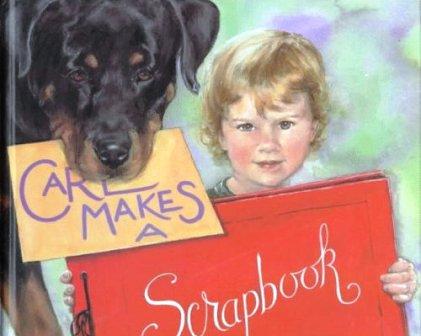
|
|
Carl goes to daycare
Publisher : Farrar, Straus and Giroux, 1995. Comment : The lovable Rottweiler returns, this time accompanying his young owner on a visit to a daycare center. When the teacher accidentally gets locked outside, Carl takes charge. His reading skills stand him in good stead as he consults the posted list of planned activities and oversees the children in an atmosphere of controlled chaos. Day juxtaposes the indoor scenes with the imaginative but unsuccessful efforts of the teacher as she tries to get into the building. Carl finally solves that problem, too. Fans of the intelligent canine will enjoy the latest entry in the series, and many preschoolers will recognize familiar details of daycare life. |
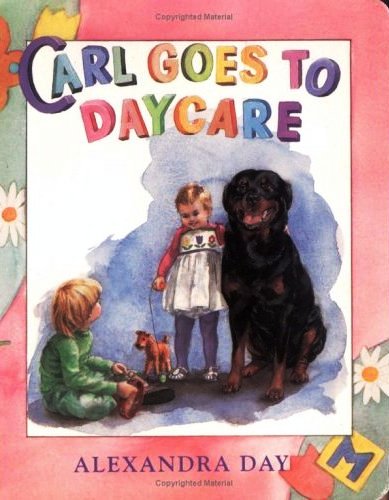
|
|
Carl's birthday
Publisher : Farrar, Straus and Giroux, 1997. Comment : This nearly wordless picture book continues the fantasy of the renowned Rottweiler and his wee ward. The lovable dog and his toddler mistress sneak back home from a neighbor's house, where Madeleine's mother is preparing a birthday party for Carl. From hidden vantage points they check on or assist with preparations for the festivities. The clandestine pair escape to their rightful place, taking a nap together just in time to put on party attire and return home to be greeted by guests yelling "Surprise!" Party scenes contrast brightly with everyday life in another winner for Carl's fans. |
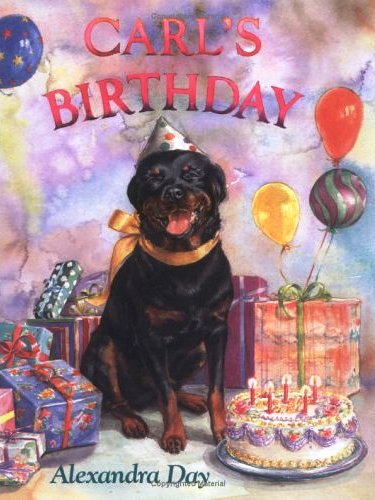
|
|
Follow Carl
Publisher : Farrar, Straus and Giroux, 1998. Comment : Day's latest does not lead the pack of her almost wordless picture books about the baby-sitting rottweiler Carl, but it nevertheless offers an idyllic vision to its readers. Carl and baby Madeleine are supposed to be napping when the neighborhood children approach the bedroom window and suggest a game of Follow the Leader. "You can be the leader!" they tell Carl amid the book's sole passage of text. Less mischievous than in his previous appearances (skipping out during naptime is Carl's only real prank here), the irresistible rottweiler conducts the children on a walk through suburban fields, pausing to lead them in stretching out their back legs, marching atop a short stone ledge, etc. With Madeleine riding Carl pony-style, they go to town, sit up and beg (successfully) for treats at a bakery and try out the revolving door of a well-stocked toy store. By the time Madeleine's mother comes to check on the nappers, everyone (including Carl's old friend the Irish terrier) is back in Madeleine's bedroom, striking sleeping-dog poses. Carl is at his doggiest: he has the kids rolling over, carrying sticks in their mouths and chasing a squirrel. Day's watercolors look so natural that it's possible to believe the story for a minute or two-certainly, the combination of grassy settings, friendly village shops and, of course, tender companionship adds up to an excursion virtually any reader would enjoy. All ages. |
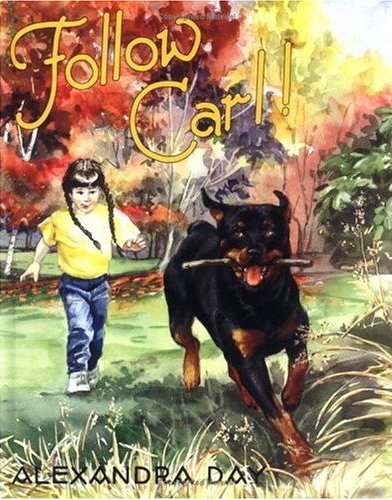
|
|
Carl's sleepy afternoon
Publisher : Farrar, Straus and Giroux, 2005. Comment : Twenty years after making his debut in Good Dog, Carl, the Rottweiler who has charmed a generation of readers has lost none of his appeal—or his spunk. Here Madeleine's mother tells Carl that she and her daughter are going shopping so he "can have a nice nap." Not likely. When the driver of a thrift-shop van arrives to pick up donated items, Carl helps him load the goods and then jumps into the back of the vehicle, scooting out at a bakery where Madeleine and her mother have stopped. The cherubic tot gleefully spots Carl through the window and surreptitiously feeds him a cookie after he slips inside. The canine hero helps a pharmacist by delivering medicine to a vet, again meets up with Madeleine at a flower stand (where he purloins a bloom and places it in a woman's shopping bag) and rescues puppies from a burning garage. The dog arrives at home, just ahead of his owners. As in past Carl tales, Day injects wry, child-pleasing flourishes: for instance, Carl's appearances go undetected by Madeleine's mother. Playing the key role in relaying the action, Day's stunningly realistic, brightly hued illustrations are as timeless and endearing as the plot. Carl fans young and old will cheer his return as they discover that this anything-but-sleepy canine is aging very well indeed. |
 Page
Page
|
|
The Yellow Balloon.
Publisher : Handprint, 2004. Comment : Using the same approach as the author's Let's Go (2001), this oversize, wordless picture book, originally published in the Netherlands, is a combination of Where's Waldo and The Red Balloon. It opens as a blue SUV departs from a lone house, a yellow balloon floating in the sky above. After being swallowed up in a busy, colorful metropolis, the car proceeds on a worldwide tour, captured in double-spread vistas viewed from overhead. Each scene is crammed with myriad, tiny details that collapse time, placing the contemporary, the historical, and the fantastic side-by-side (an aircraft carrier on the ocean passes a sea serpent and wooden warships exchanging broadsides). The car and the yellow balloon provide the "narrative" thread, until their journey ends, right where it began. Don't expect a story. The appeal is the discovery of new and recurring images within each brightly colored milieu --a coven of witches in the forest, Batman in a corner, a fakir on a magic carpet, a fugitive in prison-striped garb. The art demands repeated viewings, and the more you look, the more you see. --- Julie Cummins |
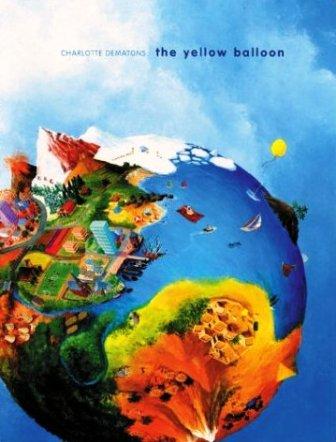
|
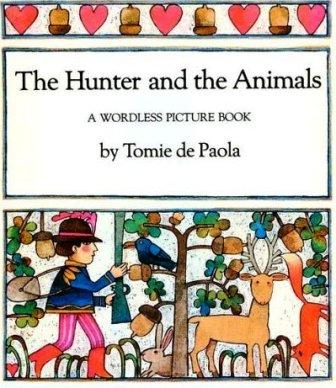
|
|
Pancakes for breakfast
Publisher : Voyager Books, 1978. Comment : This wordless picture book follows the trials of a little old lady who attempts to make pancakes for her breakfast. “The optimistic determination of the woman and the gentle humor of the illustrations make this an appealing book for the very young.. |
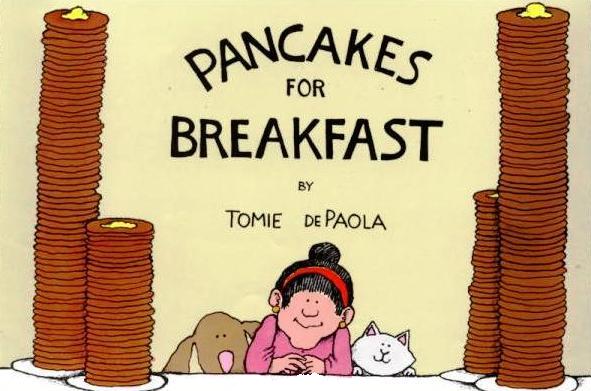 Page
Page
|
|
I Can't Sleep
Publisher : Walker Childrens Paperbacks, 1999. Comment : It is not only the winsome girl on the cover of this wordless picture book who can't sleep, but her father, brother, mother and cat as well. Insomniacs will sympathize with the illustrator father who sits wide awake and round-eyed in his dark bedroom, trying unsuccessfully to work and finally being cheered by the appearance of his daughter. One by one the drowsy family members stumble to the kitchen where they have an unexpected middle-of-the-night feast and go outside to watch the stars. Before the night is over, all four are snuggled in one bed, and they fall asleep just as morning sunlight pours through the window. Dupasquier's ( Dear Daddy ; A Country Far Away ) watercolors, appropriately hushed and rumpled, have a lively cinematic quality that fully fleshes out not only the storyboard sequence of action but the characters as well. |
|
Up to Ten and Down Again
Publisher : Mulberry, 1995. Comment : When a lone duck paddling across the clear blue water of a pond observes two cars filled with three dogs, four boys and five girls who have come for a picnic, he quickly swims to the lower corner of the picture and crawls into the border. From this vantage point, he watches as the children play with balls, sail toy boats and, with two adults, eat a picnic lunch. When the wind blows billowy clouds and rain into the picture, causing the people to pack up and leave, the duck returns safely to his pond, where he is joined by nine of his friends. This is a counting book extraordinaire. At the bottom of each page a large numeral is shown in a box along with the name of the object featured in the illustration. The objects (cars, balls, boats, etc.) also appear in boxes at the top or bottom of the page. Thus, each illustration offers two chances to count the objects, as well as the opportunity to match each boxed object with its counterpart in the picture. Single- and double-page illustrations of charming animals and children done in bright pastels are outlined and detailed in red ink. The book has the semblance of a photo album, for each illustration appears to be attached with corners to its gray-green border. The result is an imaginative wordless story book that will delight children young and old as it reinforces counting skills. --Susan Scheps |
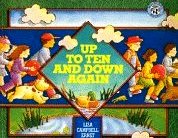
|
|
Adventures of Polo
Publisher : Roaring Brook Press, 2006. ISBN : 9781596431607 Comment : Polo is a delightfully engaging and most resourceful canine. Equipped only with a small backpack filled with a few necessities, he roams the world and beyond, venturing from the ocean depths into outer space and everywhere in between. Whether traveling by boat, plane, spaceship, or swiftly scuttling cloud, this plucky pup is always primed for his next escapade, all the while collecting friends from the four corners of the universe. Young readers will be charmed by this hound, and be awed by his ingenuity. Somewhat similar to a graphic-novel format, this wordless picture book contains bold, colorful, cartoon panels that are sure to captivate even the most finicky youngster. --–Debbie Lewis O'Donnell |
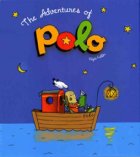
|
|
Polo: The Runaway Book
Publisher : Roaring Brook Press, 2007. ISBN : 9781596431898 Comment : Polo, the irrepressible and resourceful pooch readers first met in The Adventures of Polo (Roaring Brook, 2006), returns when a little alien steals his new book. He gives chase up strings, down ladders, through a fun-house mirror, in the air, and-well, wherever Faller's fertile imagination takes the little canine. Equipped only with his backpack and dogged determination, Polo follows the thief through graphic-novel-style wordless panels from one fantastic series of improbable adventures to another. Along the way he makes friends, effects rescues, and dodges danger in unexpected ways that will delight readers and confound expectations. Never at a loss in any crisis, the pup pulls from his backpack full banquets, a tuba, rope, and any number of items to help him overcome sticky situations. The chase's conclusion is satisfying, and all of the characters join Polo at his home for a grand celebration. The uncluttered, bright art has plenty of child appeal. Young readers will return often to pore over and revel in Polo's imaginative exploits. --—Marge Loch-Wouters |
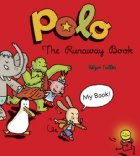
|
|
The Boat
Publisher : The Creative Company, 1993. Comment : This is a very lovely little book. It has no words, only beautifully-painted pictures. The little mouse scampers over a blank book and carefully chews away at the page, revealing the ocean underneath. He proceeds to make a little paper boat with the page and sails away to adventures on the high seas. |
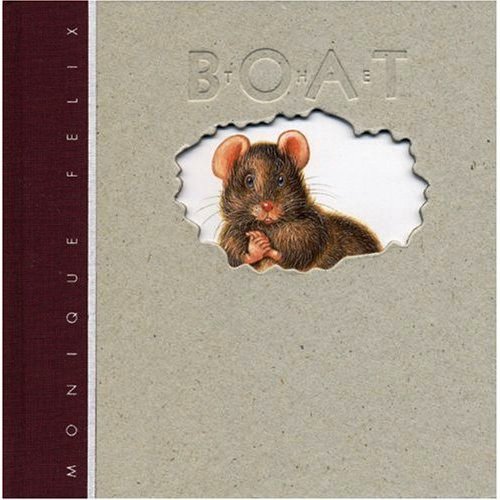
|
|
Sidewalk Circus
Publisher : Candlewick, 2004. Comment : As posters advertising the world-renowned Garibaldi circus are put up along a busy city block, a girl waiting for a bus watches the circus of everyday life unfold. There is no actual text to the book, just the words of store signs, a scrolling theater marquee, and the show bills. What the girl imagines is revealed through the playful shadows of the people on the street and the corresponding circus flyers. For example, as a chef flips pancakes into the air in the café, the corresponding poster promises "Fantastic feats of juggling." Vignettes of the girl waiting on the bench convey her growing sense of wonder as she discovers the parallels with the everyday. Appropriately enough, as she leaves on the bus at the end of the book, her place is taken by a wide-eyed boy who seems destined to find new parallels of his own. --–Robin L. Gibson |
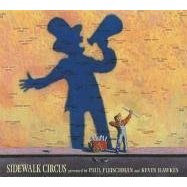
|
|
Hogwash
Publisher : Houghton Mifflin, 2008. Comment : It's bath time! All the little piggies have had lots of fun playing, and now they're dirty, muddy, and covered in paint. But their mamas aren't worried—they have just the machine to turn this Herculean task into an adventure. Anyone who has ever been captivated by the swaying brushes and spinning jets of soap and water at the car wash will be in hog heaven as Arthur Geisert's intricate etchings reveal the inner workings of an enormous contraption that can lather and scrub a whole farm full of dirty little piglets in no time at all—and that's not just a bunch of hogwash!. |
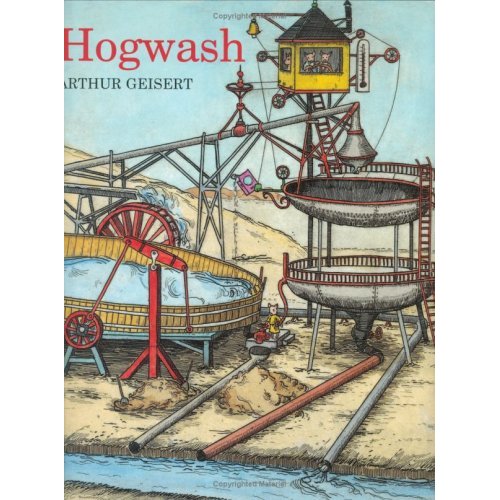
|
|
Lights Out
Publisher : Houghton Mifflin, 2005. Comment : A small pig creates an ingenious way to turn his light out at 8 p.m., as his parents require, but also to have the time he needs to settle into sleep before the room goes dark. His elaborate, Rube Goldbergian construction will have young readers poring over each page as a sequence of mechanical events unfolds. Only a few words introduce the story, but the visual narrative is lively and complex, showing the movement of each object in turn as the action runs up to the roof, down the walls, through the yard, into the basement, and so on. The porker sinks under the covers and his parents read calmly in the living room while the extraordinary machine does its work around the house. Readers will notice that the plans for this lights-out contraption are tacked up on the walls of the small pig's room, and that he's left some of his tools lying about. A wonderful and sweet attention to detail. Fans of roller-coaster construction, marble runs, and contraption-like machines will be immediately engaged, and the problem-solving humor is for everyone. The fine lines and small scale of Geisert's color art work perfectly to give an effect that is intimate, energetic, and delightful. --- Kathie Meizner |
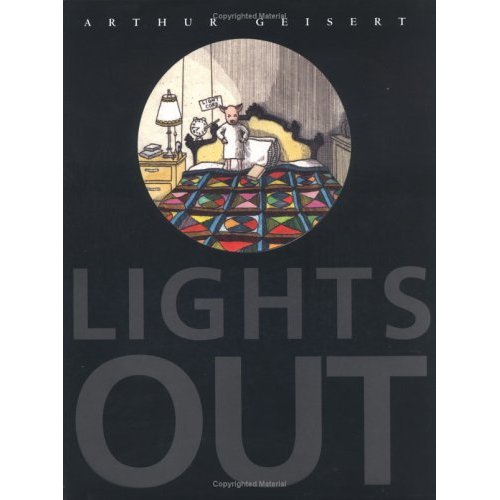
|
|
Oops
Publisher : Houghton Mifflin, 2005. Comment : As a pig family gathers round a table at mealtime, one piglet spills his milk. This seemingly innocuous accident unleashes an unfortunate and elaborate chain of events in this wordless picture book. As the milk seeps through a vent, it drips into a paint tray in the workroom below, causing it to tip over and fall, knocking over some tools on its way to the floor. A few more steps down the chain and a table saw is unleashed, cutting its way through one of the main supports of the house. As the dwelling careens away from the terraced hillside onto which it is built, pipes burst, weakening the roots of the tree bearing the children's tree house. And on it goes. Despite the destruction, humorous touches in Geisert's characteristic colored etchings lighten the tragedy, and there is a happy ending. Children will enjoy poring over the detailed illustrations, figuring out how one thing leads to another, and noticing more and more upon repeated viewings. Although this family might well want to cry over spilt milk, they are intact and smiling at the end, standing together amid the wreckage of their home. ---Robin L. Gibson |
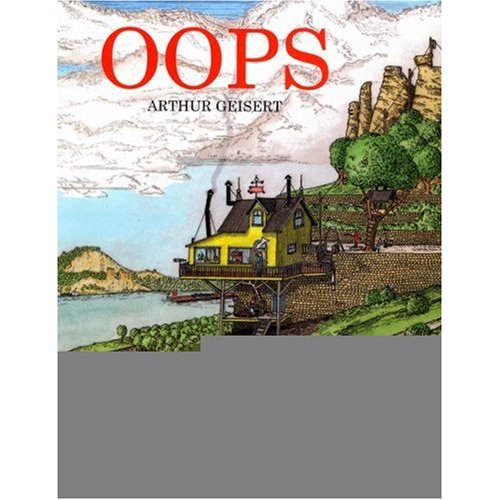
|
|
Creepy Castle
Publisher : M.K. McElderry, 1998. Comment : John Goodall illustrates beautiful wordless books, and this is no exception (so I've given this two stars, instead of one). But unlike some of his other books our family has "read" (such as Paddy Goes Traveling), this does not have a very interesting plot. In a nutshell, two mice visit an abandoned castle, are locked inside and face a few perils -- each one easily handled by the male mouse, a knight -- before safely returning home. |
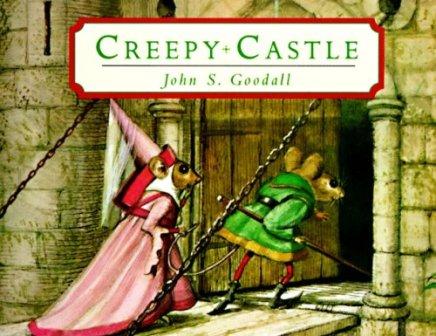
|
|
The Story Of A Farm
Publisher : M.K. McElderry, 1989. Comment : Using his trademark half-page inserts to change the dynamics of the larger double-page scenes, the artist studies an English farm from its medieval beginnings to the present day. Brief prefatory notes locate times and places, while each wordless scene, as full, respectful, and believably authentic as Peter Spier's historically set pieces, invites lingering attention. While Jorg Muller, in The Changing City and The Changing Countryside, handles a similar theme by focussing on a fixed frame over a shorter time span, here the view shifts to different parts of the farm, both exterior and interior, giving a rounder context. History lives in this companion to Goodall's earlier books. A pleasure to look at, and thought-provoking. --- Karen Litton |

|
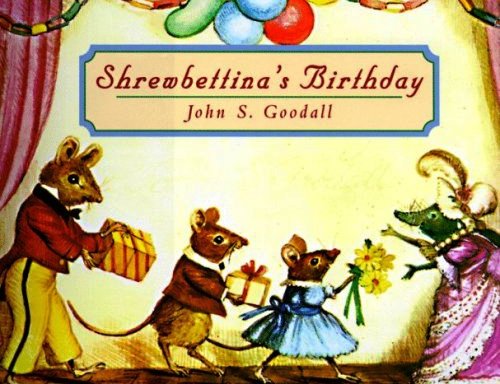
|
|
Picturescape
Publisher : Simply Read Books, 2005. Comment : A school visit to an art museum turns into an extraordinary field trip when a boy jumps into the paintings. The child is rendered in black and white and stands out against the bright landscapes that he imaginatively enters. He journeys from Canadas Pacific Northwest, across the mountains to the great plains, to the coastal Maritimes. His escape into the pictures literally changes his black-and-white world into one of color. The front endpapers and first few pages are in neutral shades of brown, gray, and black, but at the end of his trip, and on the back endpapers, elements of color appear. This is a striking, large-format book, with thick quality paper and beautifully designed. The paintings the boy enters are masterpieces of 20th-century Canadian art. --– Robin L. Gibson |
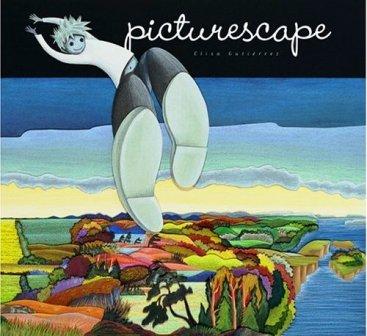
|
|
Good Night, Garden Gnome
Publisher : Dial Books Young Readers, 2001. Comment : A lush, bountiful garden is the setting for this almost wordless fantasy about the adventures of an ornamental statuette. With her dolls and stuffed animals in tow, a girl spies the gnome and adds him to her brood, but doesn't notice when a small bear tumbles from her red wagon. After an enjoyable day, the child replaces the lawn statue and takes her playthings home. At dusk, when the stars appear in the night sky, the gnome comes to life, tending the garden and caring for the animals that venture out after dark. Upon discovering the lost bear, he delivers him, at great risk, to the child's bedroom windowsill. Vivid watercolor illustrations, predominantly of intense greens, depict plush, velvety animals reminiscent of Jane Hissey's creatures, and lavish nature close-ups with every veined leaf and blade of grass clearly delineated. The pastoral scenes play host to a variety of wildlife, including birds, slugs, mice, rabbits, and an inquisitive caterpillar that appears in the majority of paintings. A magical tale of an enchanted garden. --- Maryann H. Owen |
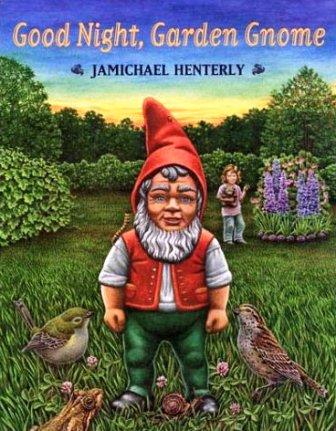
|
|
Dancing Boy
Publisher : Star Bright Books, 2005. Comment : The first image in this wordless story is of a naked blond boy dancing into a small American town. As he goes by the town's cooped up and bored children, they shed their clothes and their cares to follow this Pied Piper-like figure. The adults nearby are oblivious to the spectacle. Six children follow him but stop at the town's border while he continues on. The youngsters then return to their original places, which include a classroom, a baby carriage, and a park bench, to re-dress themselves and resume their previous activities. The last image of this visual palindrome is almost the same as the first, with the boy leaving town by the same road on which he arrived. The soft watercolors are done in a series of long, narrow panels to detail the children leaving their clothing and confinement behind while wide, full-page spreads show them freely cavorting. The art obscures aspects of their nudity that would cause serious objection. Youngsters, of course, will have their own reactions and many will find the nudity funny in a way the tone of the images does not seem to intend. The visual narrative may also fall flat for some children, since there is no change or growth for the characters left behind. While this is a provocative and artful reverie, it feels more like adult nostalgia for the innocence of childhood lost than a daydream in which young children would choose to participate. --– Rachel G. Payne |
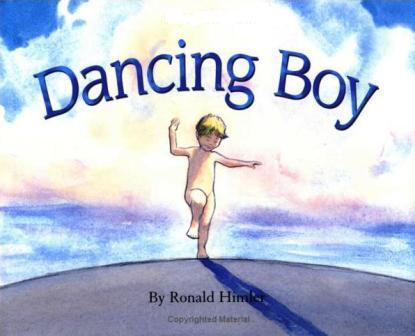 Page
Page
|
|
Up and Up
Publisher : New York : Trumpet Club, 1989. Comment : This wordless picture book really let's the imagination fly. Shirley Hughes' magical tale of a little girl whose wish to fly finally comes true has become a timeless classic. Shirley Hughes' characteristically detailed and humorous illustrations require no accompaniment as the daredevil young girl's escapades leap off the page. --Philippa Reece |
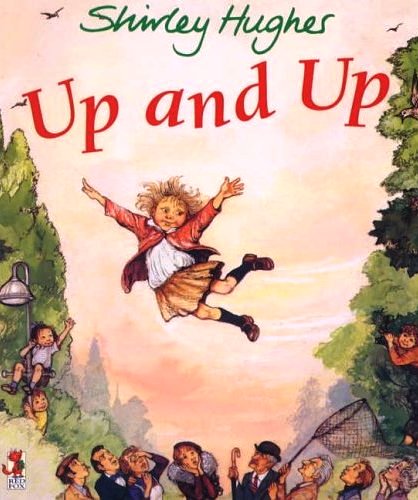 Page
Page
|
|
Changes, Changes, Changes
Publisher : Aladdin, 1987. Comment : The little wooden couple are happy in their building-block house -- until it catches fire. The solution? They transform the house into a fire engine! But then there's so much water that they have to build a boat... The very youngest can "read" this charming, wordless picture book all by themselves. |
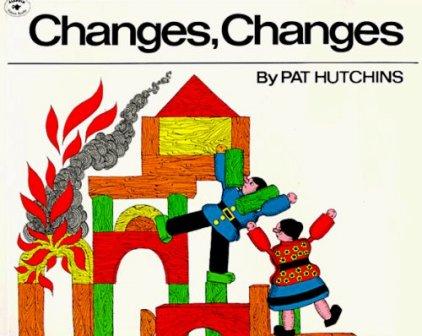
|
|
Looking Down
Publisher : Houghton Mifflin, 2003. ISBN : 9780618310982 Comment : The Earth floats in space, a small blue marble, growing with each turn of the page. The North American continent swells until the streets of a (fictional) coastal town become visible, then a particular neighborhood; a dot on the sidewalk becomes a boy with a magnifying glass, viewing-what? A ladybug fills the last page. Using neat, sharp-edged paper collages and pure, simple colors, Jenkins convincingly conveys, better than most aerial photography, both a sense of height and an almost vertiginous feeling of movement in this wordless fall. ---John Peters |
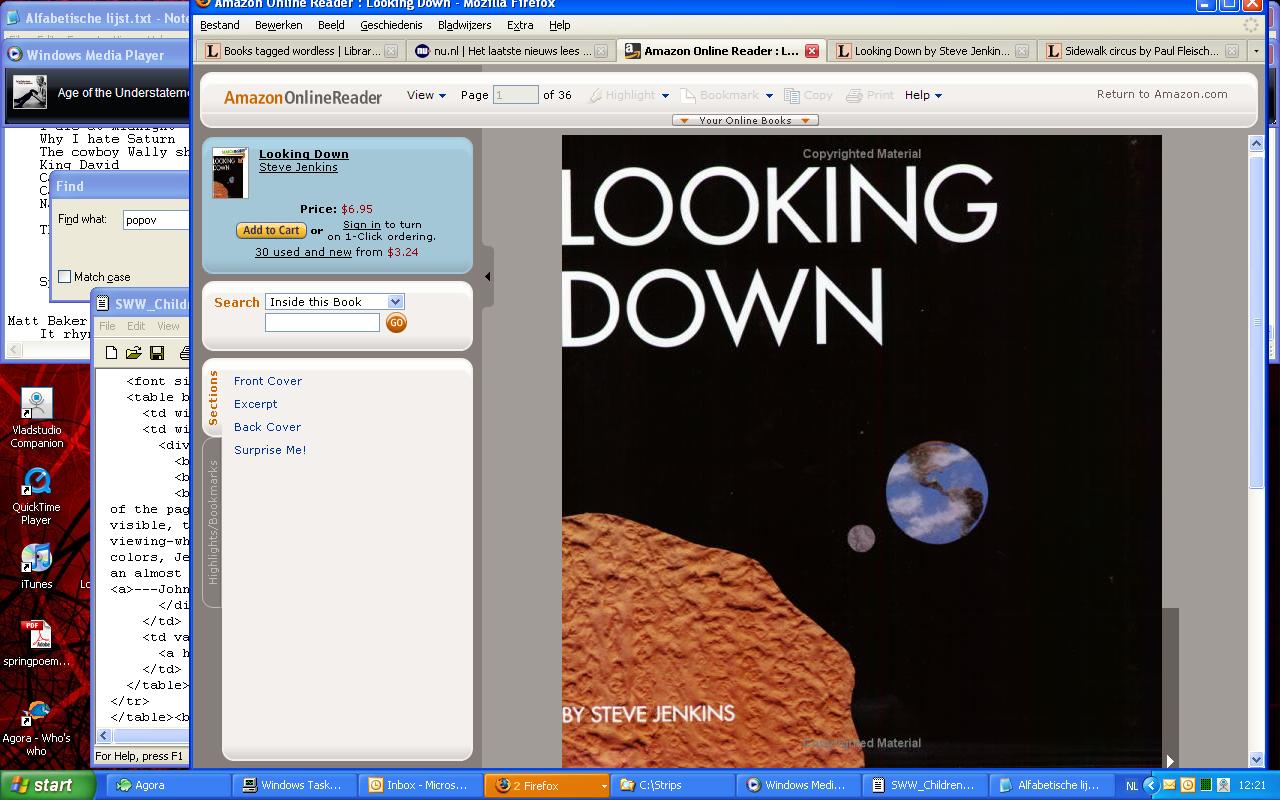
|
|
Alphabet City
Publisher : Puffin, 1999. ISBN : 9780140559040 Comment : This is a very creative book that highlights the alphabet that is all around us. Each page has an every day object like a traffic light that almost looks the shape of a letter. This would make another good choice for an interactive read aloud lesson on the letters if you had the children shout out the letter in the picture. |
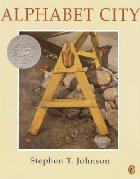
|
|
Invisible
Publisher : North-South Books, 2006. Comment : This wordless picture book is all about design. There is no apparent visual narrative, though some characters appear more than once, and there is some sequencing of events. As the solid background colors change from one spread to the next, what was previously unseen (blended into the background) becomes visible. And, correspondingly, other elements may have disappeared. The first instance is on the cover, divided into two halves, with the word invisible floating above the word visible. The prefix in, rendered in lime green against hot pink on the top half, completely blends into the lime green below. When children catch on to the visual tricks, they will turn the pages back and forth to find what they may have missed. Clothes disappear into the background, leaving what appear to be floating heads and hands–until the page is turned. While the previously missing clothes may now appear, something else may have vanished. The vivid tones of the book are a bit garish at times. While adults may moan at some of the tricks (when the invisible dog appears, he is urinating), children will enjoy the game of visual hide-and-seek. They will also smile at the humorous ending, in which a character strips off his clothes to blend in perfectly with the background, so all that is revealed is a wink and a smile. --– Robin L. Gibson |
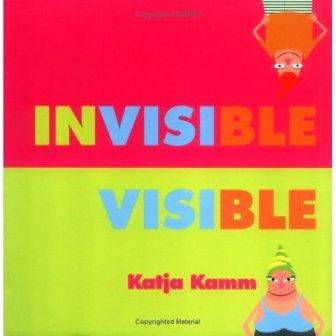
|
|
Clementinas Cactus
Publisher : Viking Children's Books, 1999. Comment : Keats departs from his traditional style for his one and only wordless picture book, Clementina's Cactus. Clementina and her father are out for a walk in the desert when Clementina discovers a lone cactus, all shriveled and prickly. But Clementina discovers there is something beautiful hiding inside that thick skin. |

|
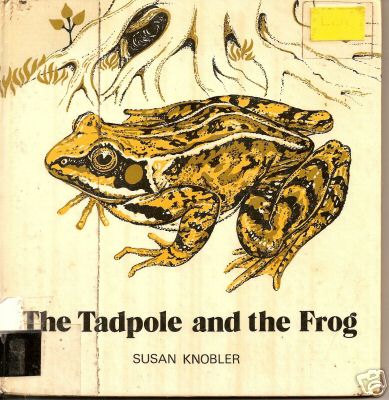
|
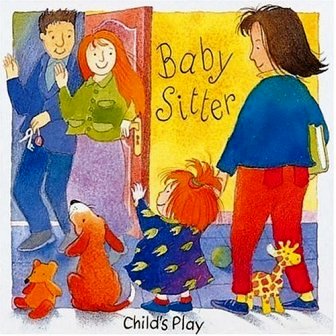
|
|
Bedtime
Publisher : Monarch Books, 2002. Comment : A book to tell a story without words but so descriptive it doesn't need any. Each page contains a scene which leads up to bedtime (saying goodbye to friends, putting toys away, bathtime, brushing teeth,storytime, etc.) My 1 year old son is not that interested in sitting still to be read books to but he will happily sit down for this one - any time of the day. I guess he recognizes each scene from his own life and loves to re-live those moments. I find it very positive how both parents are portrayed in this book as equal participants in the bedtime 'ritual'. |
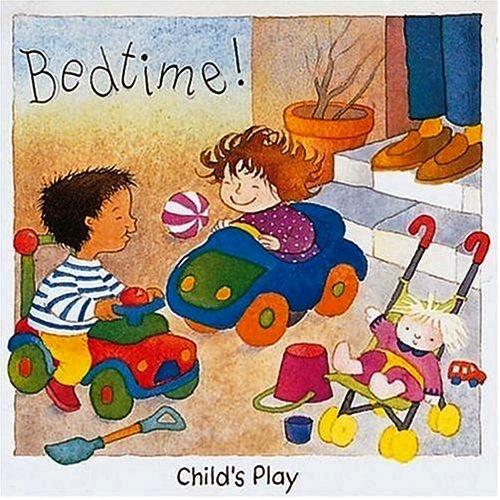
|
|
Wave
Publisher : Chronicle Books, 2008. Comment : In this evocative wordless book, internationally acclaimed artist Suzy Lee tells the story of a little girl's day at the beach. Stunning in their simplicity, Lee's illustrations, in just two shades of watercolor, create a vibrant story full of joy and laughter. |
 Page |
|
Rainstorm
Publisher : Houghton Mifflin, 2007. Comment : The author of Museum Trip (2006) returns to a wordless format to tell this story of a boy who finds that the house he lives in offers more than he imagines. The book opens to a picture of a boy looking out tall windows as rain spatters the panes. Bored and lonely, the child wanders the house and finds a key and a chest. Opening the chest, he discovers a ladder leading to a basement; then he goes through a door and up a staircase. This Alice in Wonderland-like journey ends on a sunny island, where the boy meets some children to play with. The boy goes home after a thrilling day, but he finds a way to return to see his friends. Once again, Lehman provides purely colored, precisely rendered artwork that capably captures both adventures and emotions. Unfortunately, this rather straightforward story leaves little space for children to use their imaginations. It does, however, beautifully capture the deja vu feeling that comes when reality mingles with the longing of dreams. --- Ilene Cooper |
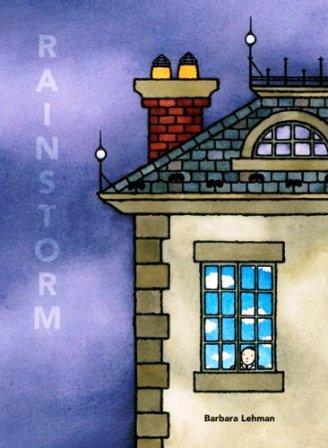
|
|
Museum Trip
Publisher : Houghton Mifflin, 2006. Comment : In this wordless follow-up to The Red Book (Houghton, 2004), in which the characters enter the pages of a book, a boy enters a work of art. During a school visit to a museum, he stops to tie his shoe and loses his group. While searching for it, he comes across a display case filled with old mazes that capture his attention. On one spread, he is looking closely at a particular drawing, and the page turn shows him physically inside of it. He enters several different labyrinths; at the center of the last one, he finds a tower with a door and goes inside. Readers view him through a keyhole and see him receiving a medal. Afterward, he locates his classmates, but as they depart, youngsters will note that he still has his medal. The museum director also wears one: they are clearly both part of a special group. The bright, clean cartoons are done in watercolor, gouache, and ink. Single- and double-page paintings alternate with smaller panel illustrations. Close-ups of the protagonist walking through each maze are mixed with pulled-back shots that reveal the entire puzzle, with the boy a small figure inside of it. Children will pore over the cleverly detailed, interactive artwork. --- Julie Roach |
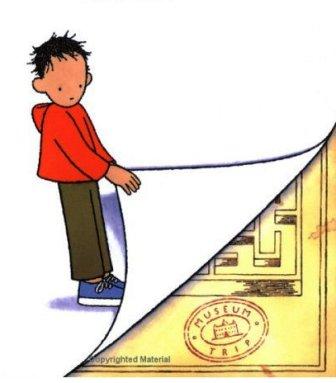 Page
Page
|
|
The Red Book
Publisher : Houghton Mifflin, 2004. Comment : In this wordless mind trip for tots, Lehman develops a satisfying fantasy in a series of panels framed with thick white borders. The effect is of peering through portals, an experience shared by the characters as they independently stumble across enchanted red books that provide them with a videophone-like connection. Though wordless picture books often seem to be the province of fine artists indulging in high-concept braggadocio (as in Istvan Banyai's 1995 Zoom), Lehman's effort ensures child appeal with an unaffected drawing style and a simple, easy-to-follow story line about a friendship forged between a city girl and a faraway island boy. The message about the transporting power of story will moisten the eyes of many adult readers, but children will most appreciate the thought-provoking visuals, in which characters' actions influence the course of their own storybook narratives--likewise affecting the larger "red book," cleverly packaged to mimic the shape and color of its fictional counterpart. Ideal for fueling creative-writing exercises. --- Jennifer Mattson |
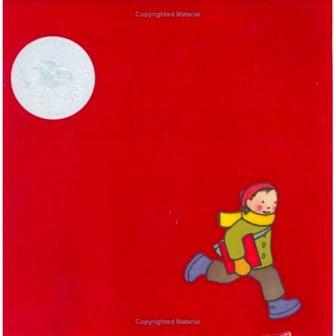
|
|
Trainstop
Publisher : Houghton Mifflin, 2008. ISBN : 9780618756407 Comment : A ride on the train is exciting. There's always something new to see, even if you've been there before. But some train rides are better than others . . . What if a train took you somewhere else entirely? What if the doors opened in a strange, new place? This is one train stop you won't want to miss! |
 Page
Page
|
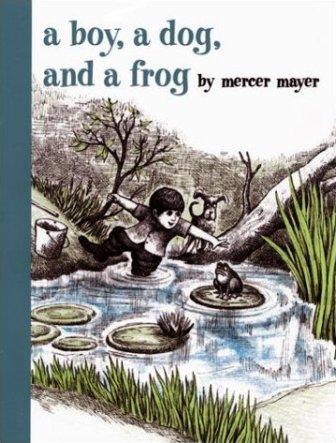
|
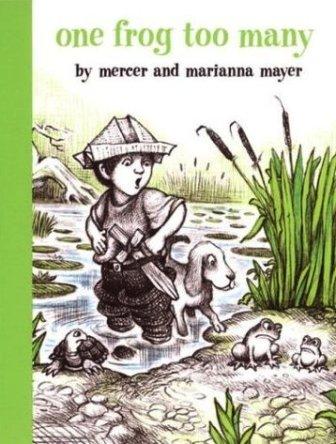
|
|
Frog Where Are You
Publisher : Dial Books Young, 2003. Comment : Mercer Mayer's classic wordless tales of a boy and his animal pals are now available in attractive, low-priced hardcover editions. These delightfully funny books follow a young boy as he romps through the woods, making mischief and new friends along the way. This series launched Mercer Mayer's distinguished career over twenty-five years ago, and is just as fresh and appealing today. |
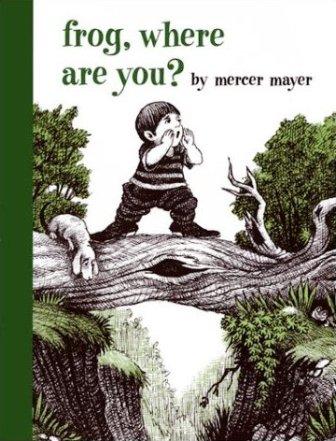
|
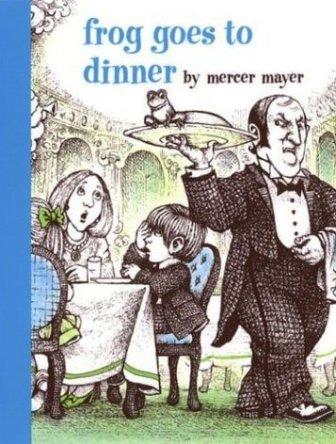
|
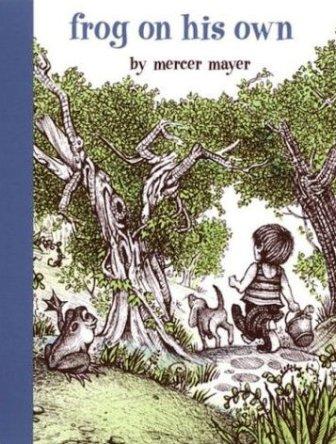
|
|
Picnic
Publisher : HarperCollins, 1984. Comment : In this book, a merry, chaotic family of mice set out for a picnic in their red pickup. As they bounce along the bumpy dirt road, Little Bitty falls off the back of the truck. Accompanied only by a pink stuffed animal, Bitty cries a little, forages a little, and waits a little. Meanwhile, the parents discover that Bitty is missing, and all the mice search the picnic site frantically, pile into the truck, and then head back down the road, where they find her waiting. Every child who has felt lost, even for a moment, will savor the happy reunion. Page layout varies from broad, double-page paintings of a single scene to several smaller pictures on a white page. Defined by McCully's precise, energetic line drawings and brightened with washes in warm, rich colors, the ink-and-watercolor artwork will appeal to children and adults alike. With a short text and sun-dappled illustrations, this book captures the feeling of the best summer days: so joyful, so splendid that even the sad tale of a little lost mouse is sure to end happily. --- Carolyn Phelan |
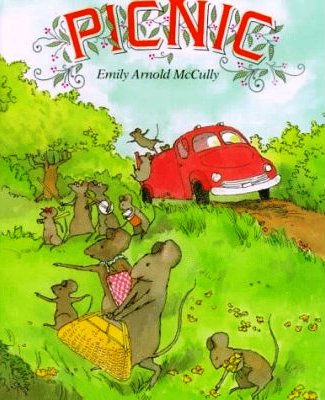 Page
Page
|
|
Four Hungry Kittens
Publisher : Dial Book Young Readers, 2001. Comment : In this wordless picture book, four little kittens living on a farm wait for their mother to bring home food. The mottled watercolor spreads show the kitties scampering around the barn, as the mother stalks outside and later follows several mice into the feed room. Throughout, a large black-and-white dog watches over the family. When a kitten falls into a container of milk, the dog alerts the farmer; when the mother cat gets locked in the feed room, the dog stands by the door until it is opened. There's an engaging story line, but the ending may bother some children: the pictures show the cat bringing in a mouse and the kittens playing with it or perhaps getting ready to eat it. Fortunately, the pictures are impressionistic, so it's hard to tell just what's happening; some children, however, are bound to ask about the mouse's fate. --- Ilene Cooper |
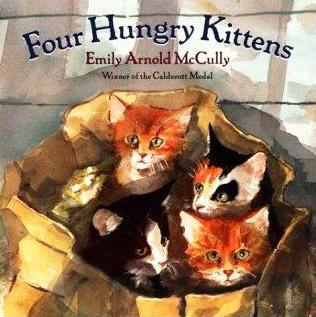
|
|
Goodnight, Dear Monster !
Publisher : Random House, 1980. Comment : Helps children with sleeping disorders. |
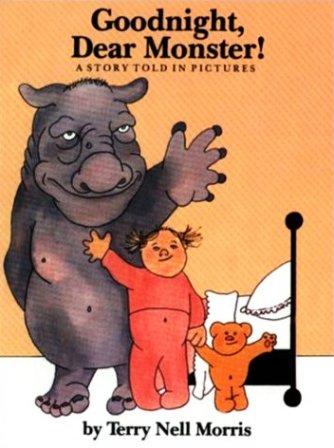
|
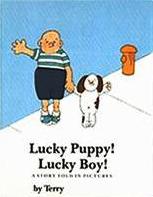
|
 Page
Page
|
|
Sunshine
Publisher : Frances Lincoln, 2004. Comment : It's morning, and the first rays of sunlight shine into a little girl's bedroom, waking her up. She gets out of bed and matter-of-factly starts her day. This award-winning wordless picture book follows the girl as she goes about her morning routine and watches as her parents do the same. She eats cereal, climbs in bed with her parents who read the paper and drink coffee, brushes her teeth, gets dressed, and goes out the door ready for school. Preschool-age children will enjoy providing their own commentary and comparing their personal routine to hers. |
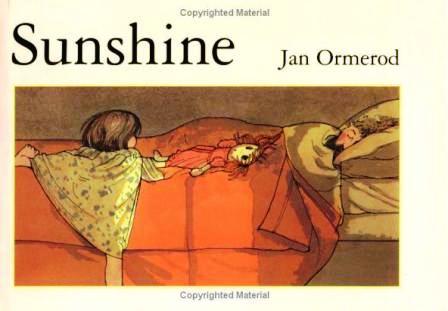 Page
Page
|
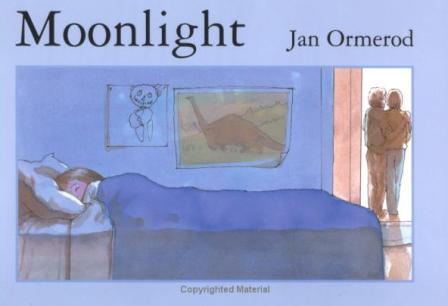 Page
Page
|
|
Why ?
Publisher : North-South Books, 1996. Comment : A frog dressed in long johns sits on a rock, peacefully smelling flowers. Out of the ground pops a mouse (in overalls) with an umbrella. A new friend? Hardly. The mouse attacks, the frog falls off the rock and seizes his flower. Frog, however, has large friends, who drive the mouse away. Back comes the rodent, with his friends, in a wheeled contraption with a gun. Retreating, the frogs come up with wheeled contraptions of their own. By the end, the once-idyllic scene has become a war zone, dotted with blackened wreckage, in which frog, with a shattered umbrella, and mouse, holding a crumpled flower, sit with sad, puzzled expressions. Unlike most of its thematic kin, from Dr. Seuss's Butter Battle Book (Random, 1984) to Umberto Eco's The Bomb and the General (Harcourt, 1989), the accomplished illustrations in this wordless antiwar parable are deceptively pretty, with delicate lines, misty backgrounds, and soft blues and greens that gently blend into each other. Despite escalating battles, there's no visible death or physical injury; Popov's intent seems to be to surprise readers a bit, then to provoke their thoughts and discussion. --- John Peters |
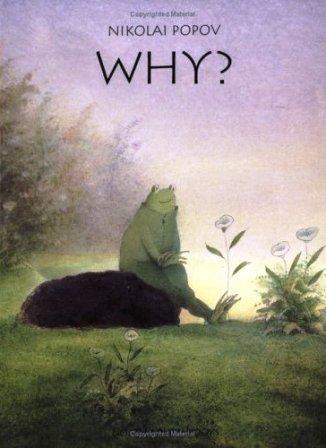 Page
Page
|
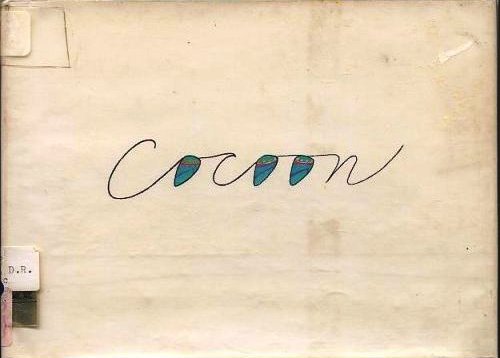
|
|
The Boy, The Bear, The Baron, The Bard
Publisher : Roaring Brook, 2004. Comment : This wordless picture book adds a new twist to the Shakespeare canon for young audiences. When a boy's wayward soccer ball lands inside a theater and suddenly transports its owner through time to the Globe, the Elizabethan era comes to life. Unfortunately, the lad's sudden appearance on stage interrupts the performance, and the Bard himself, investigating the problem, suddenly slips on the ball and comes crashing down. He chases after the culprit, and the boy runs for his life. Fortunately, the mid-afternoon crowds provide much-needed camouflage from the angry playwright, and the child, after befriending a chained bear, leads his newfound grizzly companion into the Tower of London, where they free a Baron awaiting beheading. The three then embark down the Thames where they encounter the royal barge, and Elizabeth I is quite taken by the once-condemned Baron. As night descends, Shakespeare suddenly reappears, angrier than ever, and the boy and the bear barely escape with their skins. Just when all seems lost, the boy flees back to the Globe where, heading through the curtain, he finds himself once more safe and alone–in modern times. Rogers's tale shows a very human facet of the Bard–his temper. The details portrayed in the pen-and-watercolor illustrations are true to the era. The cartoon paintings vary in size from tiny renderings to full-page spreads, and they are filled with movement and expressive faces. This sophisticated romp will attract the eyes of intermediate audiences, and could serve as a good prelude to the study of Shakespeare and his times. --– Nancy Menaldi-Scanlan |
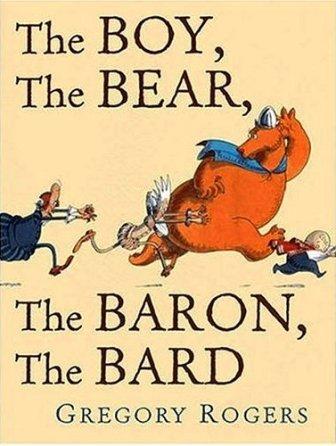 Page
Page
|

|
|
Time Flies
Publisher : Crown Books, 1994. Comment : In this wordless journey back in time, a bird flies into a museum filled with dinosaur skeletons. The walls dissolve and the skeletons take on flesh, coming to life. In a dramatic picture, the bird is eaten by what appears to be a Tyrannosaurus Rex. But the dinosaur's flesh fades away, as gradually and mysteriously as it had first appeared, and the bird flies free, easily escaping from what is again nothing but bones. The columns of the museum's grand hall reappear, and the bird flies off into the sky, watched by a pterodactyl gargoyle. This impressive effort is rather like David Wiesner's Tuesday (Clarion, 1991), sharing its elements of technical expertise and surreal fantasy. Rohmann's oil paintings (all double-page spreads) show the inside of the museum in warm, burnished browns and reds, while the colors are cooler and more varied in the outdoor light of the prehistoric scenes. Unusual perspectives and striking compositions and images make for a dynamic and intriguing book. The picture of the bird balanced on the teeth of the skeleton is a remarkable juxtaposition of delicacy and strength. --– Lauralyn Persson |
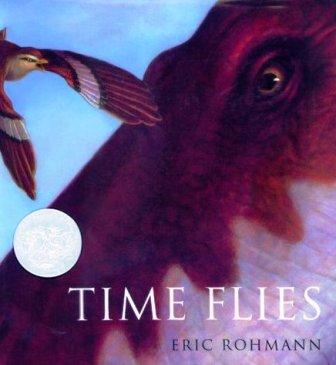 Page
Page
|
|
Breakfast For Jack
Publisher : Front Street, 2004. Comment : From the illustrator of the immensely successful Biscuit series comes a new set of books in an exciting new series for prereaders. Breakfast for Jack follows the adventures of Jack, the playful family dog who lives in a very busy household. Captivating and easy to follow, this wordless storybook introduces prereaders to storytelling. |
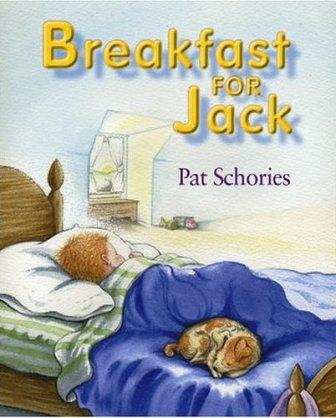
|
|
Jack and the missing piece
Publisher : Front Street, 2004. Comment : From the illustrator of the immensely successful Biscuit series come a new set of books in an exciting new series for prereaders. Jack and the Missing Piece follows the adventures of Jack, the playful family dog who lives in a very busy household. Captivating and easy to follow, this wordless storybook introduces prereaders to storytelling. |
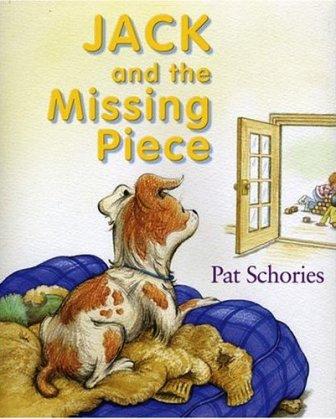
|
|
Jack and the Night Visitors
Publisher : Front Street, 2006. Comment : After seeing a strange light through the bedroom window, Jack the dog and his boy discover that a little spaceship has landed on the roof outside their window. A crew of tiny, jolly robotlike aliens soon make themselves at home in the boy's room, and the earthbound hosts overcome their initial trepidation as they feed the curious creatures and watch them explore. When the boy traps an alien in a jar, however, the others run for the ship, and Jack steps in to help the tiny captive escape. From the series that began with Breakfast for Jack (2004) and Jack and the Missing Piece (2004), this wordless picture book offers colorful illustrations that have a lucid narrative thread as well as many rewarding details. Schories, best known as the illustrator of Alyssa Satin Capucilli's Biscuit books, shows strong visual storytelling skills here, and her high-interest premise and accessible artwork will make this book a rewarding choice for children not yet ready to read on their own. --- Carolyn Phelan. |
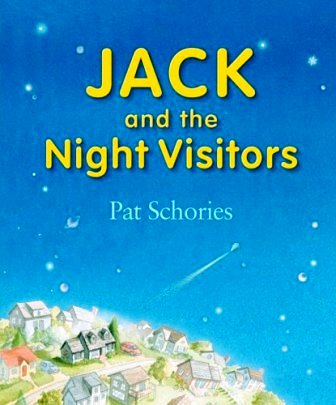
|
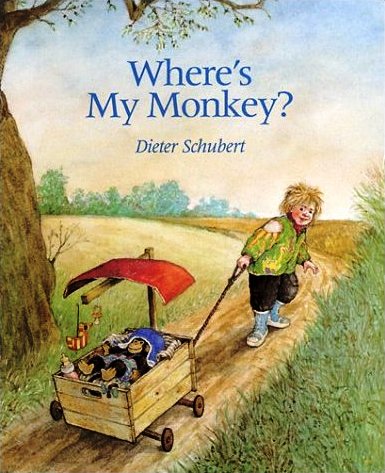
|
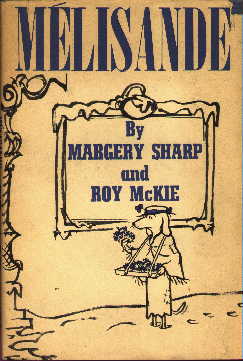
|
|
Dinosaur!
Publisher : Harper Collins 2000. Comment : A wordless picture book that takes readers on a wild adventure of the imagination. A boy and his toy dinosaur are in the tub when a larger dinosaur appears, and then another, and as the beasts loom larger, the boy and his surroundings become smaller. The culmination is a three-page spread revealing a full-color herd of dinosaurs racing across the page, and if children look very closely, they'll see a tiny boy in his tub. Then, magically, the oversized creatures disappear, and all that are left are the boy and his bath toy and his mother, who appears with a towel. This imaginative story with wonderful endpapers naming the creatures should appeal to all young dinosaur lovers. S's's barely fleshed-out, cookie-cutter cartoons tell the story. He masterfully plays with white space and perspective, conveys action, and captures a full range of emotions with the absolute minimum of line and detail. As in Fire Trucks (1998) and Trucks, Trucks, Trucks (1999, both Greenwillow), the author's bold artwork and simple plot are right on the mark for this audience. --- JoAnn Jonas |
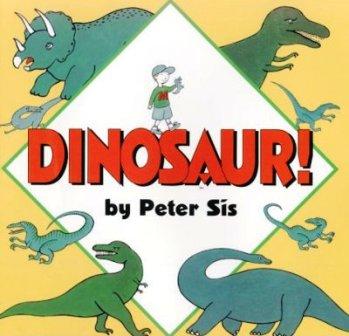 Page
Page
|
|
Flying Jake
Publisher : Aladdin Paperbacks, 1996. Comment : his wordless picture book is sure to be more than most children can comprehend. Jake, a small boy, allows his bird to escape from its cage, and as Jake reaches out to catch it, he too can suddenly fly. The illustrations, done in muted chalk tones of yellow, brown, and mauve, exhibit the chaos and happiness that Jake causes when he is as free as a bird. --- Carol McMichael |
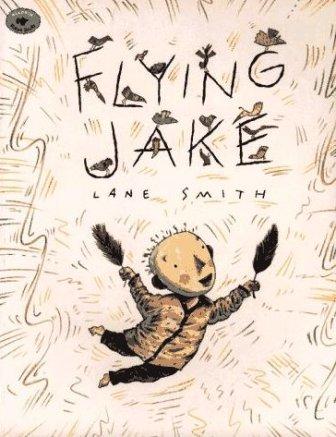
|
|
Peter Spier's Rain
Publisher : Yearling, 1997. Comment : This wordless picture book captures the beauty and wonder of a brother and sister's joyous experiences in the rain. Come along as they explore their neighborhood, splash through puddles, see where the animals hide, and make footprints in the mud. From the first small drops of rain to the clear blue sky of a bright new morning, Peter Spier's Rain will delight parents and children again and again. |
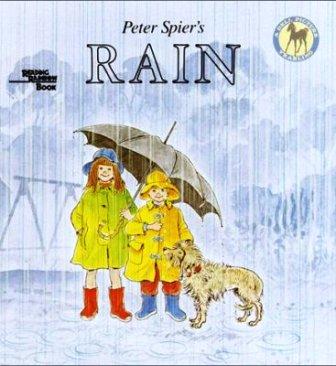 Page
Page
|

|

|
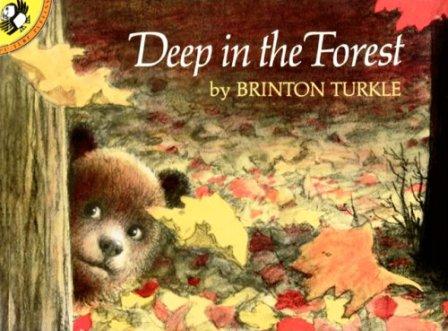
|
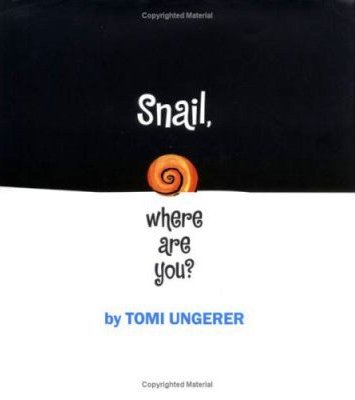 Page1
Page2
Page1
Page2
|
|
A Day, A Dog
Publisher : Boyds Mills Press, 1995. ISBN : 9781886910515 Comment : This wordless picture will have a limited audience. With supreme economy of line, Vincent's black-and-white sketches relay what happens to a dog after he is forced out of a car and abandoned. The artist records the events matter-of-factly: the creature attempts to follow his owners, narrowly escapes being hit on the street (while causing a major accident-the central action), pees on a parked car in the midst of the chaos, and makes his way to a nearby town. There he encounters a lonely looking boy, resulting in an open-ended conclusion. While the illustrations are engaging, most children will find the existentialism bewildering. Purchase where sophisticated picture books are appreciated. ---Wendy Lukehart. |
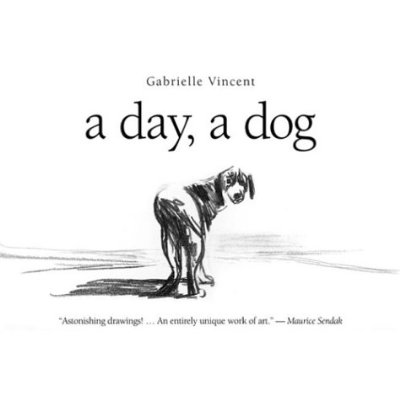 Page1 Page2 Page3 Page4 Page5 Page6 |
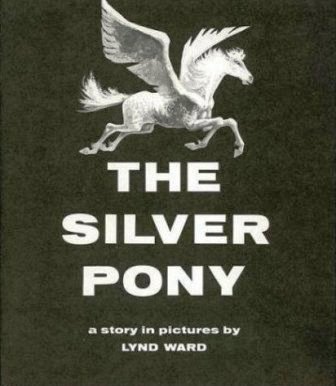
|
|
You Can't Take a Balloon into the Metropolitan Museum
Publisher : Dial Books, 2001. Comment : Wordless picture books have always held an honored place in the hearts (and lesson plans) of all teachers who promote a love of reading. YOU CAN'T TAKE A BALLOON INTO THE METROPOLITAN MUSEUM takes that tradition to new heights with its exquisite detail, subtle parallel events, humor and excitement. It has all the elements of story: setting, lively characterization, the conflict and the chase...not to mention a most satisfying ending! But beyond all these delights, teachers of children of all ages will be drawn to this book for its potential to lead young minds on a quest for further information in many areas: art, art history, cultural tradition. It will find its place in creative writing lessons and in lessons about cultural history. And it will inevitably fix the images of a great museum in the minds of "readers," many of whom will find their way to The Met to discover these visual treasures in "real life." --Ann P. Kaganoff. |
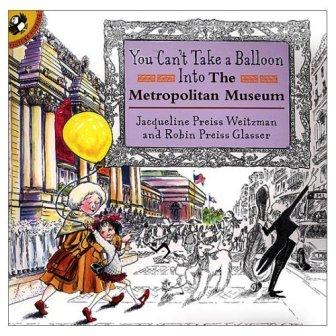 Page1
Page2
Page1
Page2
|
|
You Can't Take a Balloon into the National Gallery
Publisher : Dial Books, 2002. Comment : Since this is not her first trip to a museum, this little girl knows her bright orange balloon will not be allowed inside the National Gallery of Art in Washington, D.C. The solution seems simple: Ask the kindly photographer in front of the museum to look after the balloon. But while the girl, her brother, and her grandmother are inside, the balloon sails away, starting off a collision of art, history, and urban life that becomes increasingly comical and exciting. |
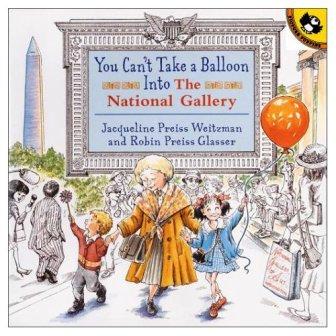 Page1
Page2
Page1
Page2
|
|
You Can't Take a Balloon into the Museum of Fine Arts
Publisher : Dial Books, 2002. Comment : After a visit to the Metropolitan Museum and the National Gallery, this series' third book finds a girl, her grandparents and a green balloon in Boston, You Can't Take a Balloon into the Museum of Fine Arts by Jacqueline Preiss Weitzman, illus. by Robin Preiss Glasser. Like its predecessors, the wordless adventure features actual art reproductions amidst lively line drawings; famous Bostonians appear throughout. |
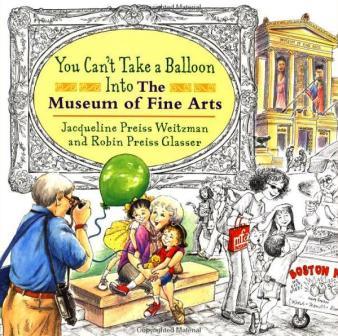 Page1
Page2
Page1
Page2
|
|
Flotsam
Publisher : New York: Clarion, 2006. Comment : A wave deposits an old-fashioned contraption at the feet of an inquisitive young beachcomber. Its a Melville underwater camera, and the excited boy quickly develops the film he finds inside. The photos are amazing: a windup fish, with intricate gears and screwed-on panels, appears in a school with its living counterparts; a fully inflated puffer, outfitted as a hot-air balloon, sails above the water; miniature green aliens kowtow to dour-faced sea horses; and more. The last print depicts a girl, holding a photo of a boy, and so on. As the images become smaller, the protagonist views them through his magnifying glass and then his microscope. The chain of children continues back through time, ending with a sepia image of a turn-of-the-20th-century boy waving from a beach. After photographing himself holding the print, the youngster tosses the camera back into the ocean, where it makes its way to its next recipient. This wordless books vivid watercolor paintings have a crisp realism that anchors the elements of fantasy. Shifting perspectives, from close-ups to landscape views, and a layout incorporating broad spreads and boxed sequences, add drama and motion to the storytelling and echo the photographic theme. Filled with inventive details and delightful twists, each snapshot is a tale waiting to be told. Pair this visual adventure with Wiesners other works, Chris Van Allsburgs titles, or Barbara Lehmans The Red Book (Houghton, 2004) for a mind-bending journey of imagination. --– Joy Fleishhacker |
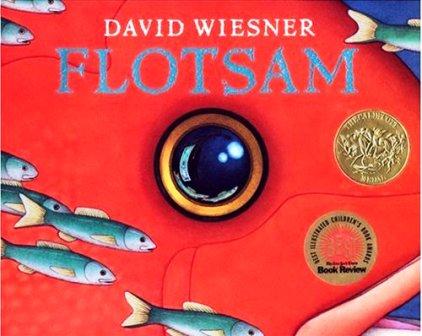
|
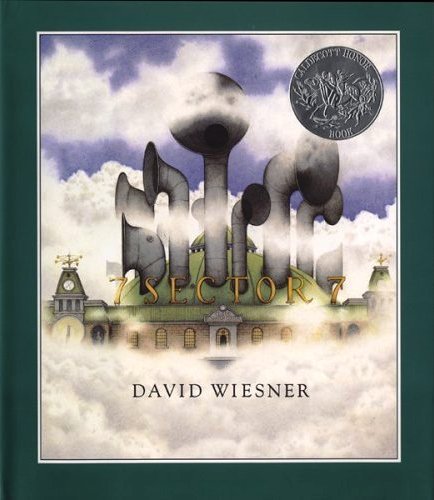
|
|
Tuesday
Publisher : New York: Clarion, 1997. Comment : "Tuesday evening, around eight"--a deceptively mundane beginning for what proves to be a thrilling, miraculous, and surreal amphibian journey. Slowly and quietly on this particular Tuesday, a few fat frogs begin hovering over a swamp, riding lily pads like magic carpets. Clearly satisfied and comfortable, the floating frogs are as serene as little green buddhas. Gradually, the flying fleet grows in momentum and number, sailing over the countryside and into an unsuspecting town. These frogs know how to have fun--startling the occasional bird, waving webbed feet at late-night snack-eaters, and even changing the channels on a sleeping granny's television. As day breaks, the frogs lose their lily pads, head back to the pond, and wait impatiently for their next scheduled departure. Tuesday won the 1992 Caldecott Medal and, among other honors, was named as an ALA Notable Children's Book. The critical acclaim will come as no surprise to anyone who opens the pages of this beautiful and humorous book. With hardly any words (except those noting the time), David Wiesner creates a wondrous romp as silent as the middle of the night. Using the rich purples, blues, and greens of late evening, Wiesner draws readers into the warm, incandescent world of frog flight. "Read" this wordless wonder to children and savor it for yourself as well. Chances are, you and the youngsters will both find yourselves poised at the window, hoping to catch a few airborne frogs in the act. |
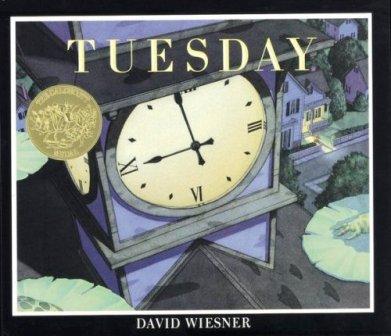 Page
Page
|
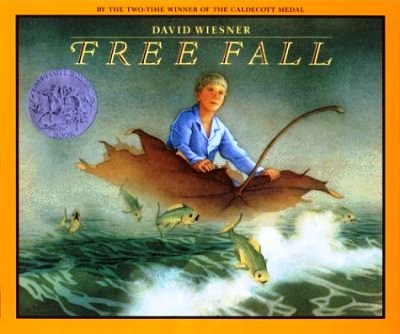 Page
Page
|
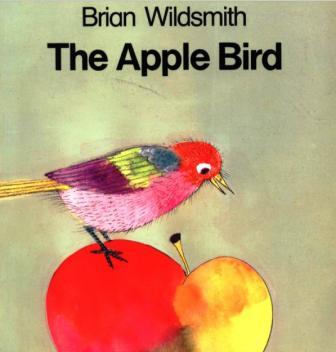
|
|
The Entertainer: A Story in Pictures
Publisher : Boston: Alyson Publications, 1992. Comment : Line art story of a boy who is discovered juggling in the park, becomes a famous entertainer, and eventually goes back to juggling in the park. The passage of time is conveyed by vignettes of a tree and its leaves. |